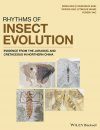By: Dong Ren(Editor), Chung Kun Shih(Editor), Taiping Gao(Editor), Yongjie Wang(Editor), Yunzhi Yao(Editor)
707 pages, colour photos, colour & b/w illustrations, colour tables
![Rhythms of Insect Evolution Rhythms of Insect Evolution]()
Click to have a closer look
About this book
Contents
Customer reviews
Related titles
About this book
This book showcases 23 different orders of insect fossils from the Mid Mesozoic period (165 to 125 Ma) that were discovered in Northeastern China. It covers not only their taxonomy and morphology, but also their potential implications on natural sciences, such as phylogeny, function, interaction, evolution, and ecology. It covers fossil sites; paleogeology; co-existing animals and plants in well-balanced eco-systems; insects in the spotlight; morphological evolution and functional development; and interactions of insects with co-existing plants, vertebrates, and other insects. The book also includes many elegant and beautiful photographs, line drawings, and 3-D reconstructions of fossilized and extant insects.
Rhythms of Insect Evolution: Evidence from the Jurassic and Cretaceous in Northern China features chapter coverage of such insects as the: Ephemeroptera; Odonata; Blattaria; Isoptera; Orthoptera; Notoptera; Dermaptera; Chresmodidae; Phasmatodea; Plecoptera; Psocoptera; Homoptera; Heteroptera; Megaloptera; Raphidioptera; Neuroptera; Coleoptera; Hymenoptera Diptera; Mecoptera; Siphonaptera; Trichoptera and Lepidoptera.
- Combines academic natural science, popular science, and artistic presentation to illustrate rhythms of evolution for fossil insects from the Mid Mesozoic of Northern China
- Documents morphology, taxonomy, phylogeny, and evolutionary changes of 23 orders of insects from the Middle Jurassic and Early Cretaceous faunas in Northern China
- Presents interactions of insects with plants, vertebrates, and other insects based on well-preserved fossil evidence
- Uses photos of extant insects and plants, fossil and amber specimens, line drawings, and 3-D computer-generated reconstruction artworks to give readers clear and enjoyable impressions of the scientific findings
- Introduces insect-related stories from western and Chinese culture in text or sidebars to give global readers broader exposures
Rhythms of Insect Evolution: Evidence from the Jurassic and Cretaceous in Northern China will appeal to entomologists, evolutionists, paleontologists, paleoecologists, and natural scientists.
Contents
List of Contributors
Preface
1 Jurassic-Cretaceous Non-Marine Stratigraphy and Entomofaunas in Northern China
2 Coexisting Animals and Plants in the Ecosystems
3 Insects – In the Spotlight
4 A History of Paleoentomology in China
5 Ephemeroptera – Mayflies
6 Odonata – Dragonflies and Damselflies
7 Blattaria – Cockroaches
8 Termitoidae – Termites
9 Orthoptera – Grasshoppers, Locusts, Katydids, Crickets, and Weta
10 Notoptera – Rock Crawlers and Ice Crawlers
11 Dermaptera – Earwigs
12 Chresmodidae – Water-Walking Insects
13 Phasmatodea – Stick Insects and Leaf Insects
14 Plecoptera – Stoneflies
15 Psocoptera – Barklice and Booklice
16 Homoptera – Cicadas and Hoppers
17 Heteroptera – True Bugs
18 Megaloptera – Dobsonflies, Fishflies, and Alderflies
19 Raphidioptera – Snakeflies
20 Neuroptera – Lacewings
21 Coleoptera – Beetles
22 Hymenoptera – Sawflies, Wasps, Bees, and Ants
23 Diptera
24 Mecoptera – Scorpionflies and Hangingflies
25 Siphonaptera – Fleas
26 Trichoptera – Caddisflies
27 Lepidoptera – Butterflies and Moths
28 Insect Feeding
29 Camouflage, Mimicry or Eyespot Warning
30 Gene Propagation – Courtship, Mating, and Next Generation
Customer Reviews
By: Dong Ren(Editor), Chung Kun Shih(Editor), Taiping Gao(Editor), Yongjie Wang(Editor), Yunzhi Yao(Editor)
707 pages, colour photos, colour & b/w illustrations, colour tables



































